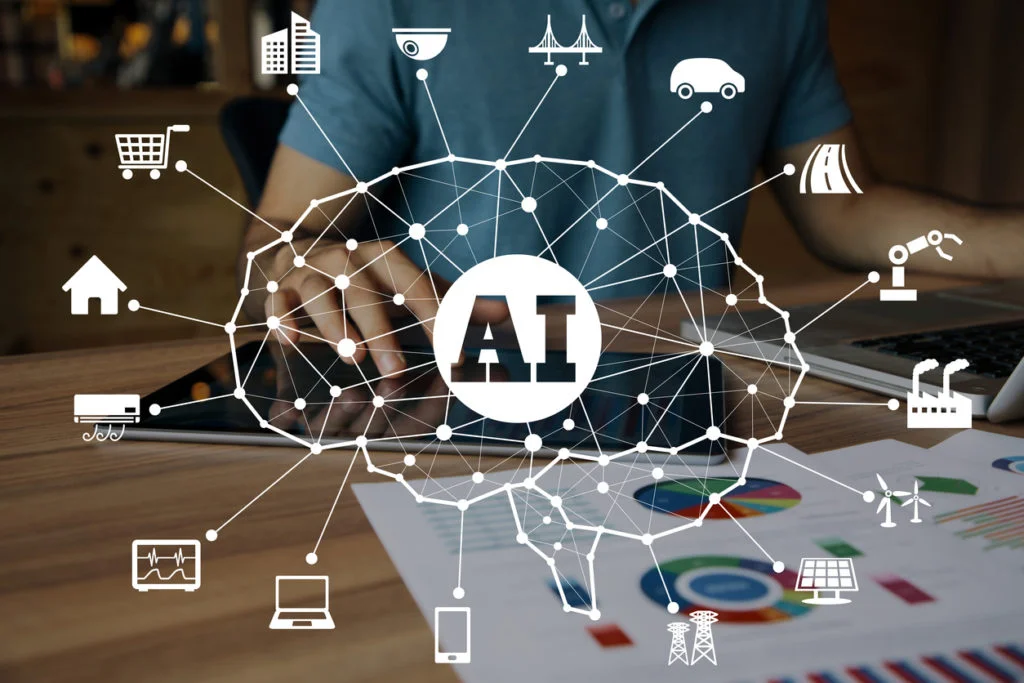Artificial intelligence (AI) is a formidable technology with the potential to revolutionize industries and enterprises. Companies in industries ranging from oil and gas to retail, banking, health and wellness, and real estate are implementing AI to enhance operations, increase efficiency, and drive development. However, implementing AI projects can be costly, and understanding the return on investment or ROI in AI projects is critical.
This article will examine real-world examples of AI initiatives taken by medium and small-sized businesses and their ROI across many sectors.
Understanding ROI for AI Projects
ROI is an important indicator for firms to consider when assessing the performance of their AI projects. It compares the benefits a corporation receives from an investment to the expense of that expenditure. ROI is computed by dividing the net gain from an investment by the cost of the investment.
However, ROI in AI projects may differ. Instead of direct monetary gains, these net results might be enhanced efficiency, more accuracy, lower costs, and better decision-making.
Real-World Examples of AI Projects and ROI from Various Industries
Real Estate Industry
The real estate sector has seen considerable changes in recent years, with the introduction of artificial intelligence playing a big part in altering how the industry runs. From property appraisal to purchasing and selling, AI has solved numerous industrial difficulties. In this part, we will look at two AI initiatives in the real estate business that have shown a favorable ROI.
- Compass’s AI-Powered Video Studio for Virtual Property Tours
Since the epidemic, the real estate market has seen significant changes. The largest loss came from the absence of property tours and showings, a crucial component of the industry’s profitability. Compass’s real estate brokerage company created Video Studio in 2020 as part of its search for a workable solution. This AI-powered technology turned property photos and stated qualities into a virtual tour video.
Compared to Q1 of 2020, the company’s overall sales increased by 80% in 2021. Additionally, Compass increased the number of transactions by 67% even though the US residential market only saw a 14% growth.
Compass agents vowed by the Video Studio to quickly produce excellent listing videos. Following the use of this AI technology, Compass released other AI products and steadily moved up the industry success ladder. The corporation now has a $1 billion net worth.
- Roof.ai’s AI-Enabled Real Estate Imaging and Analytics Platform
A real estate tech business called Roof.ai offers real estate professionals visual data with AI capabilities. The business’s AI technology examines photos and videos of properties, identifying things and gleaning pertinent information. The software leverages this information to produce precise property values, which aid real estate brokers in setting competitive prices for their listings.
The platform developed by Roof.ai has shown 3x more monthly return on investment for its users by lowering the time and effort needed for property appraisals. Real estate agents used to manually value properties, which was time-consuming and frequently prone to human mistakes. However, real estate agents can quickly and accurately produce property valuations using Roof.ai’s AI-enabled platform, which increases efficiency.
The company’s overall revenue is close to $5 million.
Oil and Gas Industry
The oil and gas industry is one of the world’s most significant and profitable sectors. AI has enabled businesses in this sector to simplify operations and raise profitability. Here are two examples of AI in the oil and gas industry:
- Upwing Energy’s AI-Driven Upstream Oil and Gas Solutions
The creation of artificial lift technology for the oil and gas sector is the area of expertise of Upwing Energy, a California-based business. Electric submersible pumps (ESPs) used in oil and gas extraction are optimized using the company’s unique technologies, which combine cutting-edge algorithms with machine learning. With the help of Upwing’s technology, oil and gas production progressed to become more productive, and equipment breakdowns happened less frequently.
Upwing’s AI algorithms analyze the ESP data to find trends pointing to upcoming equipment breakdowns. The maintenance crew is then informed of possible issues through warnings sent by the algorithms, which allows them to take preventative measures. The technology also enables operators to remotely monitor and modify the performance of ESPs, enhancing their effectiveness and lowering the necessity for expensive on-site trips.
The efficacy of oil and gas production is increased by Upwing’s technology, which has been shown to lower the incidence of equipment breakdowns. Upwing’s clients have reported an increase in monthly revenue ranging from $200,000 to $2.6 million per well. The company made $3.8 million in revenue in 2023.
- OspreyData’s AI-Enabled Predictive Maintenance and Failure Analysis for Oil and Gas Equipment
The OspreyData platform employs machine learning to find patterns and correlations in data that might be early indicators of equipment breakdown. The technology produces predictive maintenance alerts enabling businesses to plan repairs and maintenance before equipment failure occurs. The evaluation of historical data and sensor readings helps get these insights.
OspreyData’s predictive maintenance solution dramatically impacts the oil and gas industry’s bottom line. Companies save money and have $10.9 billion in increased annual revenue on maintenance, repairs, and lost output by decreasing downtime and improving equipment dependability. Additionally, the capacity to plan maintenance and repairs can increase the equipment’s lifespan and cut down on capital expenses.
The company successfully raised $5 million in Series A financing organized by Houston Ventures.
Retail Industry
Retail has been significantly disrupted in recent years due to the advent of e-commerce and shifting consumer tastes. Retailers are turning to AI technology to streamline their operations and improve consumer experiences to remain competitive.
- Allbirds’ AI-Powered Supply Chain Optimization for Sustainable Footwear
In recent years, a devoted following has grown for the well-known ecological footwear company Allbirds. The business has always been dedicated to utilizing eco-friendly products and lowering its carbon footprint, but to further improve sustainability and profitability, it has been looking into the application of AI in its supply chain activities.
Ensuring that its products are obtained and manufactured sustainably is one of the issues that Allbirds tackles. The business cut waste, improve shipping routes, and lessen its environmental effect by utilizing AI algorithms to examine data on raw materials, production processes, and transportation techniques.
Additionally, Allbirds uses AI to forecast consumer demand for its goods and change its inventory levels as necessary. It improves the company’s sustainability efforts by preventing overproduction and lowering the quantity of surplus inventory that must be thrown away.
The net revenue of Allbirds by the end of 2022, with a 7% increase from the previous year, was $297.8 million. The company’s sustainability goals are also attracting young crowds and celebrities, making the business more robust in an already saturated sneakers industry.
- Focal Systems’ AI-Driven Grocery Store Management System
A business named Focal Systems has created an AI-driven technology to assist grocery retailers in streamlining their processes and enhancing the consumer experience. The system combines cameras, sensors, and machine learning algorithms to monitor shop shelves, analyze inventory levels, and give store staff real-time information.
Reducing the time staff spend on manual inventory tracking and replenishing is one of the system’s main advantages. It helps eliminate out-of-stock products and guarantees that shelves are constantly fully supplied, improving consumer satisfaction and saving time and labor expenses.
By examining data on consumer behavior and purchasing trends, the technology from Focal Systems also assists retailers in strengthening their pricing strategy. Stores may modify their prices and promotions to match customer demand better and boost sales by utilizing this data to detect which goods are most in demand and which aren’t selling.
For many North American retailers, FocalOS successfully increased their ROI by 50 times or $140 million annual benefit. By 2021, Focal System’s annual revenue was closing at $9 million.
Finance Industry
The finance industry was one of the first to utilize AI technology. AI-powered solutions transform how banks and financial institutions work, providing major benefits such as cost savings, higher efficiency, and better client experiences.
- Zest AI’s AI-Powered Credit Risk Assessment for Small Businesses
Due to their lack of credit history or insufficient collateral, small company owners sometimes have trouble obtaining inexpensive finance. Platforms for assessing credit risk driven by AI have been created recently to deal with these issues.
A California-based firm, Zest AI, offers a platform for credit underwriting that uses AI algorithms to scan a wider range of data sources. Moreover, it finds creditworthy customers who would have been turned down using conventional underwriting methods.
The technology from Zest AI has been shown to enhance approval rates while keeping risk at the same level as conventional underwriting techniques. The platform developed by Zest AI has also decreased the frequency of defaults, which has allowed lenders to save a lot of money.
A credit union working with Zest AI reported an incremental monthly gain of $1 million in 2021. By 2021, Zest AI’s revenue was $21 million.
- Plaid’s AI-Powered Data Aggregation for Financial Services
Plaid, a San Francisco-based start-up, offers a platform for data aggregation driven by AI that enables financial institutions to access and examine their clients’ financial data. Their platform employs machine learning to classify and examine financial transactions, spot trends, and produce insights.
This behavioral analysis and insights let financial institutions provide tailored products and services, boost customer engagement, and cut costs.
Carvana, SoFi, and Copilot are just a few companies using Plaid’s platform. The platform also makes building new financial applications like investing and budgeting tools easier. Improved consumer engagement and retention are other benefits of these apps.
A buy now, pay later company, Zip, used manual screening methods to minimize fraud. After using Plaid’s AI solutions, the company can now monitor 8 million people simultaneously, saving 15.5 hours a month.
Plaid’s valuation by 2021 had already reached $13.4 billion.
Health and Wellness Industry
Integrating AI into products and services has also greatly influenced the health and wellness industry. AI has assisted individuals in better tracking their health and making more informed decisions, from wearable technologies to health coaching applications.
- OURA’s AI-Powered Smart Ring for Personal Health Tracking
The OURA ring is a wearable gadget made by the Finnish business OURA. The ring features sensors that track the wearer’s body temperature, heart rate, and sleeping habits. OURA’s AI algorithms then analyze the data to offer consumers individualized health improvement insights and suggestions.
Thanks to OURA’s AI-powered smart ring, users better grasp their sleep habits and general health. The firm has experienced considerable growth in sales as a consequence. Additionally, by offering individualized insights and recommendations, the business has grown its customer base and improved customer retention.
The company’s valuation by 2022 raised to $2.55 billion.
- Noom’s AI-Driven Weight Loss Coaching App
Noom is a health coaching software that employs AI algorithms to provide consumers with individualized coaching and weight loss regimens. The software gathers information about a user’s dietary preferences, exercise regimen, and other health-related characteristics to develop a personalized plan that is catered to their specific requirements.
With a claimed average weight reduction of 18 pounds over 16 weeks, Noom’s AI-driven weight loss coaching app has proved successful in helping users accomplish their weight loss objectives. As a result, the company’s revenue has increased significantly, by over 100% over the previous year, according to reports. High levels of client satisfaction and retention have also been produced by the tailored approach used by the app.
By 2021, Noom’s valuation was already reaching a whopping $3.7 billion.
Best Practices for Achieving ROI in AI Projects
Although AI has the potential to generate sizable profits, success is not assured. Businesses must follow best practices to get the intended ROI from their AI projects. The excellent practices from our step-by-step ACHIEVE process for maximizing ROI in AI projects are listed below:
- Analyze the business model and assemble system requirements: It is essential to analyze the business model and assemble system requirements to develop an effective AI solution. It involves conducting workshop meetings with stakeholders to gather their requirements and using the SOAR framework to identify potential AI use cases. The requirements should be documented, and success criteria defined to ensure the proposed solution aligns with business objectives.
- Chart the course through strategy and roadmap development: Developing an AI strategy and roadmap ensures the solution meets business needs and is aligned with overall business objectives. It involves defining the business strategy, AI strategy and developing a roadmap that outlines the key milestones and deliverables.
- Harness expertise in data exploration and prepare technical specifications: To develop an effective AI solution, it is essential to have expertise in data exploration and prepare technical specifications. It involves verifying data availability, exploring it using the 5 Vs (volume, variety, velocity, veracity, and value), and designing ML models and product architecture to handle the data.
- Incorporate intelligence and elegance into UI/UX design: Incorporating intelligence and elegance into the UI/UX design is essential for ensuring users can interact with the AI solution effectively. It involves designing the product UI and developing clickable UI prototypes that can be tested with users.
- Excel and outclass in product development and ML model training: To excel and outclass in product development and ML model training, it is essential to verify AI feasibility, develop and train ML models, and deploy the application to the cloud. It requires a deep understanding of AI technologies and expertise in software development.
- Verify and validate through extensive testing: To ensure that the AI solution is high quality and meets user requirements, it is essential to conduct extensive testing. It includes verifying code and product quality, including functional, performance, and security testing.
- Ensure product success with ongoing maintenance & support: Ensuring product success requires ongoing maintenance and support. It involves updating the product roadmap with future delivery phases, establishing a data governance process, scaling the product, and providing ongoing user support. Doing so ensures that the solution remains effective and aligned with business needs.
Conclusion
Businesses increasingly turn to AI to spur innovation and gain a competitive edge since it can potentially alter whole sectors. The advantages of AI are obvious, with notable gains in effectiveness, productivity, and customer satisfaction. Companies need to invest in the appropriate personnel, infrastructure, and capabilities to fully utilize AI as it develops to stay ahead of the curve. Companies may generate 30% returns on average in coming years and stimulate innovation and growth in their sectors by adopting AI best practices.
Ready to explore the potential benefits that AI can bring to your business? Take advantage of Achievion AI Value Assessment.
Our comprehensive assessment includes a 1-hour session with AI Solutions Lead and a detailed report with AI business value analysis. Gain insights into the tangible benefits of AI technology for your company which can help you make informed decisions about your AI strategy.
Contact us today to schedule your AI Value Assessment session!









